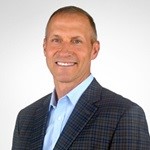Balancing challenges for employers and employees
PodcastJune 19, 2024
Record date: 03/26/24
Air date: 06/19/24
The final episode of the "Road to Relief: finding a path to accessible, affordable healthcare,” podcast miniseries, features Rick Holmes, President of Lakeshore Benefit Alliance, and Chris Howard, Head of Market Management for Zurich North America's Life Accident and Health. They provide insights into the primary challenges that American employers and employees encounter due to rising healthcare costs, including increasing premiums and out-of-pocket expenses. Listen as they discuss proactive solutions such as Stop-Loss and GAP medical supplemental health insurance products, which aim to make healthcare more affordable and accessible.
Guests:

Rick Holmes
President
Lakeshore Benefit Alliance
Rick Holmes is the President of Lakeshore Benefit Alliance, an MGA for numerous GAP and secondary Health Insurance carriers. Rick launched his insurance career in 1990 with New England Financial, selling life, disability and group insurance products. While at New England Financial he was a Top of the Table Producer, Lifetime Million Dollar Round Table Producer and part owner of Omega Re-Insurance Company.
In 2012, Rick founded Lakeshore Benefit Alliance, consulting and partnering with insurance carriers, third party administrators and brokers. Since then, LBA has become the nation’s leading producer and the MGA of GAP and Secondary Health Insurance which it markets under the proprietary brand of ALLIANCE®. LBA attributes its tremendous growth to its numerous broker partnerships, unwavering commitment to always doing the right thing and its mission to make healthcare affordable to employers and their employees.
After recognizing that all individuals are in need of the protections that ALLIANCE® provides, Rick co-founded Benefits for Everyone to address the benefits void in the Gig Economy, the independent contractor and the 1099 workforce. Rick is a graduate of the University of Alabama where he earned a degree in Finance. Rick and his wife, Susie, live in Birmingham, Alabama, and are blessed with one daughter, two sons and a soon-to-be son-in-law. Rick truly loves the insurance business and the impact that it has on people’s lives. Rick’s famous words are “Pinch me, wake me up. Who am I going to help today?”
 Chris Howard
Chris Howard
Head of Market Management
Life, Accident & Health
Chris Howard is the Head of Market Management for the Life, Accident and Health business in Zurich North America. In this role, he is responsible for driving engagement with the market to establish Zurich as the major provider in the U.S. of accident and injury insurance, as well as supporting efforts to build Zurich as the top global provider of multinational A&H coverage. The A&H portfolio includes products for Accident (corporate, student, participant, travel, occupational, voluntary benefits, and affinity markets) and Health (medical stop loss, provider excess and supplemental products intended to offset major medical plan deductibles). A&H offers market-leading propositions for both the large corporate and middle market customer segments.
Howard joined Zurich in 2020 from WNC Insurance Services where he was president of the Accident and Health division. Previously, he served as Senior Vice President of Consumer Solutions and Affinity Markets at Chubb where he was responsible for production, underwriting, operations and servicing of association, financial institution and employer-based accident and supplemental health distribution channels and a direct-to-consumer platform. Prior to that, he held leadership positions at Cross Country Automotive Services, Balboa Insurance Group, and the Assurant Group.
Host:
 Farah Rehman
Farah Rehman
Head of Marketing and Customer Strategy
Zurich North America
Farah Rehman currently serves as the head of Marketing and Customer Strategy for Zurich North America’s Life, Accident & Health business. With over 20 years of experience, she started her career at AIG in product development, then moved to sales, internal consulting and ultimately marketing. At Zurich, she began in advanced marketing and led the life sales and marketing team, prior to taking on her current role. She has a bachelor’s in management information systems from the University of Houston and an M.B.A. from Rice University. Farah lives in Houston, Texas with her husband and daughter. In her free time, she leads her daughter’s Girl Scouts troop and loves traveling the world with her family.
(PLEASE NOTE:This is an edited podcast transcript, capturing speakers with natural speech patterns that may include incomplete sentences and/or asides, grammatical errors, verbal shorthand and some statements that may be less clear in print.)
Episode transcript:
FARAH REHMAN: As healthcare costs rise, a heavy burden is carried by insurance companies, employer groups and Americans alike. Welcome to Future of Risk, presented by Zurich North America. We explore the changing risk and resilience landscape and share insights on the challenges facing businesses, to help you meet tomorrow prepared.
This is our three-part mini-series, "Road to Relief: finding a path to accessible, affordable healthcare," where we're taking a deep dive into healthcare coverage and delivery trends to better understand the problems as well as the potential solutions that can help provide access to high-quality, affordable care for everyone. In previous episodes, we've talked about healthcare challenges around accessibility and affordability.
Today in our final episode, we're focusing on benefits trends with employer groups and their employees. As well as solutions that help employer groups provide stronger benefits while mitigating key risks.
I'm Farah Rehman and I'm speaking with Chris Howard, Head of Market Management for Zurich North America's Life Accident and Health team. And Rick Holmes, President of Lakeshore Benefit Alliance, an employee benefits consulting firm in Birmingham, Alabama.
CHRIS HOWARD: Thank you.
RICK HOLMES: Thank you, Farah.
REHMAN: So, Chris, what do you see as some of the biggest issues in the healthcare system today?
HOWARD: Well, you mentioned two of them earlier. Accessibility and affordability are going [to] always be at the forefront. In general, if you think of an employer, the cost of an employer has risen in the past 10 years by about 50% for the coverages that they provide to their employees. At the same time the cost for the employees has gone up by about 60%.
And while they've used things like deductibles and copayments and what not to kind of help people to better afford those changes, medical inflation's not going away. I would say year over year, 5-10% things are expensive. Coverages are improving, treatments are improving, costs aren't. That to me is the biggest challenges I think facing us as Americans.
REHMAN: I think, for sure when we think about that limited accessibility and affordability, Chris, that you just spoke of; there are some major issues that Americans face on a personal level.
Rick, when you think about even in the employee space where people have access to, to primary health insurance, what are some trends that you've seen? If you kind of compare then versus now, what are some trends that you've seen in the employer/employee space?
HOLMES: Just like Chris said, “cost just continues to go up.” It's hard for employers to afford the portion that they want to pay on behalf of the employees. It's hard for the employees to pay their portion of payroll deduction. And of course, when you look at healthcare costs, it's really expensive.
But the sad thing is that when employees go to use the healthcare cost, they still have a lot of out-of-pocket cost. So, one of the biggest issues, cost is just going to continue to rise. One thing that is a big concern is healthcare reform has put these providers in the collection business.
So, it's really sad to see an employee who might need a meniscus or a new mom having a baby that these providers are going to now have to collect this money upfront, really making them be the bad guy on saying “we're not going to be able to provide the care until we get paid.” So, it's a big mess out there… really is.
REHMAN: Yeah, and Rick, when you think about that and for sure the affordability, having to pay that much upfront can really put pressure on a lot of Americans out there.
Chris, if we shift that over to how employers are managing those costs, what are some trends you see in terms of them managing these rising costs as they try to offer benefits to their employees?
HOLMES: I think there are about three or four different levers that an employer could pull to better, manage the costs of their healthcare. One, they could drive people into the public exchanges, obviously saving them a lot of money.
Two, they can increase deductibles and then really just increase copayments. Outside of that, as I mentioned earlier, costs are continually increasing, drives premium costs to continually increase. Those are the alternatives that I see.
REHMAN: And Rick, just shifting to you and your experiences, you've worked with different size firms, from small ones to large ones. What are some differences that you see in how smaller firms manage their health insurance benefits versus larger firms?
HOLMES: Well, if they're less than 50 — kind of like what Chris is mentioning — a lot of employers are just throwing their hands up going, "Hey, you're just going to have to go to some of the exchanges to get your healthcare and maybe we increase pay to help you pay for some of that."
Maybe the employees get a little bit of subsidy. But these smaller companies where all the pricing for these healthcare plans are all based on their employees ages when they're less than 50. And a lot of employers have a lot of older employees that are in their fifties and sixties, where their average single premium is now pushing $750, $800, $900 and it's just hard for them to be able to afford the healthcare cost. And it's hard for the employees to afford their portion. And so, health insurance is now making up a big portion of that company's overhead,
To the extent of outside of payroll is the number one two expense. So, there's a big dilemma when it comes to large employers. They're mandated on if they have over 50 full-time employees, you know what an employee can afford a certain percentage of their income. So, the government has forced them to really step up and provide a certain level of premium that an employee can pay. So, it's a little bit better.
But at their size, their claims is the number one driving factor. And just like Chris had mentioned, employers are raising these deductibles to a point where, it's almost like you need insurance for your insurance because the average deductible is four and five and six. I mean, we're seeing $9,000 deductibles out there that, before the insurance company pays, that members having to pay the first 9,000. So, it definitely has some issues in affordability for everybody.
HOWARD: We actually, even, we've done some research in the past year or two and I think that we've seen that the average deductibles from, I think, 25% of the people 10 years ago had an average deductible of $2,000 or higher. That's grown to more than 50% today.
I think the average deductible in America for the individual today is $3,300, where the average deductible for a family's over $6,700… and those are averages. So, people are having a tough time affording the premiums. They're having a tough time affording the deductibles.
Companies are having a tough time affording the premiums, which exacerbates the problem in general. So again, it's a tough problem. Like Rick mentioned it's hard to solve.
HOLMES: Chris, I had read something that 60% of Americans, given a out-of-pocket expense of more than a thousand dollars, is going to have a tough time paying. So, when you look at that average deductible now being, what did you say, $4,000?
HOWARD: $3,300.
HOLMES: $3,300. I mean, very few people are going to be able to afford that 3,300. At least we know 60% are going to be needing to pay less than a thousand.
REHMAN: Rick, when we had spoken last time, you talked about an example of how some of these issues are affecting employees. I think you had a couple of specific examples if you wanted to share how are they managing some of these challenges they're facing when they have a health issue?
HOLMES: Most providers are going to want to collect whatever their cost is going to be upfront. We had a gentleman who had a meniscus that needed to be repaired. And of course, when he had the surgery, he had to pay it up front and that was $3,500.
Then he had physical therapy. When he looked at his physical therapy, the orthopedic called for like 10 physical therapy visits. Well, he had one and he had to tell the employer that he couldn't afford the other nine physical therapy visits. He was just going to do self-physical therapy. But that was one of the things where no one can afford this cost of care.
And of course, before the care is going to be performed, that provider is going to try to collect it upfront in fear of if they go ahead and perform the procedures, like 90% chance that they're not going to be able to collect that accounts receivable. Cost of paying upfront is just the biggest issue because very few people have money sitting inside their bank account.
Whenever anybody has to have a procedure, they are looking at where am I going to get that money? It's not in their savings, family members don't have it, friends don't have it and then they go back to their employer.
Now the employer's put in a position to have to lend them the money or advance them the money. Then at that point, for the next six months that employer is deducting $25 and they've almost become a bank. And of course, if that employee leaves, then that's another dilemma.
REHMAN: A big dilemma, I think both for the employees and the employers alike. Chris, we talked a little bit about some of the solutions out there, that exist in the marketplace. You had mentioned to me earlier, Stop-Loss and as well as gap medical. Can you just very quickly talk a little bit about what each of those are and about maybe the study that we did?
HOWARD: Sure. Stop-Loss is a product whereby employers choose to self-fund health insurance. They typically leverage all of the components of a traditional health plan, like the networks and the discounting and the claim processing.
However, they choose to pay up to a certain level and then rely on insurers to take layers over and above. so that they could afford to pay the same kind of coverages but take advantage of some of those cost savings by offsetting the catastrophic exposure elsewhere.
Gap medical is one of those products that I was introduced to about 10 years ago. Again, Rick was one of those early guys that I talked to that did a really good job in Alabama of giving people in Alabama of which 95% of them relied on a single insurer.
So again, he built his business around helping those agents who distributed for that company to provide the right solutions for people and employers. But it's basically health insurance that covers up to a deductible, whereby major medical insurance covers health insurance over a deductible.
What it does for an employer, it lets employers consciously and not at the behest of an employee, raise deductibles. That saves the employer some money in healthcare spend. It lets employees access healthcare at a much lower dollar amount.
So, instead of that $3,300, with a $500 gap medical plan, an employee would start accessing benefits at $500, not $3,300. So now, you have an employer saving some money.
You have an employee saving some money and from an insurance company perspective insurance companies can price it because they don't have to worry about those $2 million critical illness claims that come about every now and again and the catastrophic side of healthcare.
So, it's kind of one of those “win-win-win” product segments that are out there. So, from a study perspective, we talked to a lot of people out there that couldn't afford to pay for.
I think you mentioned earlier, Rick, a thousand dollars. 86% of those people would've put a medical expense on a payment plan or a credit card. When we explained that there was a product like Gap Medical out there, 88% demonstrated that they were interested and 85% of those said that it would more than address their healthcare needs and asked for more information.
So again, unmet market need. Product that's been around for a while, that has healthcare costs continue to creep and cost of coverage continues to creep, it becomes more and more valuable. So, to make it more mainstream, I think is what we hope to help people like Rick in the long term do.
REHMAN: Yes, thank you Chris. Rick, can you talk a little bit about how maybe you've used some of the solutions in your business and is it possible to tailor these solutions for different groups?
HOLMES: Absolutely. Of course, just to touch base on how this product is built… the way insurance is supposed to work is the ones that don't use it pave the way for the ones that do. What I love about this is we will go into a company and they may have other methods to help their employees pay their out-of-pocket costs.
We've all heard of flexible spending accounts, health reimbursement accounts, health savings accounts. And the biggest issue with those is that if you put a hundred dollars into one of these plans, you only have a hundred dollars to spend. It takes several months, maybe even years to be able to have enough in there to help you pay your out-of-pocket costs.
The great thing about the product that Chris had mentioned with his company is that basically you can put a hundred dollars in and there's a bucket of money there that is there to help you pay your deductibles in your out-of-pocket.
It usually… it could be $5,000 that basically you paid a hundred dollars a month for 12 months, that you spent $1,200 and you got five or six thousand dollars to spend towards your out-of-pocket cost.
People can understand that. It's simple and it's easy. And the question was how is this tailored to each employer group? We go into companies where they want a $6,000 benefit, they want a $7,000 benefit.
So, of course we want to do a good job of asking questions and listening. Some want a deductible that before those benefits kick in and pay, some might want a $100 or $250 or $500 before that benefit kicks in and pays for their employees.
In Alabama, we really have a lot of strong health plans. So, we even have some that have zero deductibles. But when we go to Georgia and they're looking at our gap plans, literally it might be a $2,000 deductible before that $5,000 benefits kick in.
So, each one of our employer groups, they're able to look at one what can they comfortably afford to spend? What can an employee pay out of pocket before the benefits kick in? So, it's all very, very customizable.
That's what makes it nice that each company can look at what their employees need and what they want to provide and find the right premium that fits their needs and goals.
REHMAN: I think it's interesting. Rick, to your point, that it's not just about the size of the employer group, but it's also the region that they're in, the state they're in and of course their individual needs, the makeup of their employees. So, there's a lot of factors that can come into play to help tailor it. Chris and Rick, thank you so much for joining us today on Future of Risk.
HOWARD: Thank you.
HOLMES: Absolutely. Thank you.
REHMAN: And thank you also to our listeners for joining us for our Road to Relief, finding a path to accessible affordable healthcare miniseries. This has been Future of Risk presented by Zurich North America. If you like the show, leave a common review wherever you get your favorite podcast, or drop us a note at media@zurichna.com.
